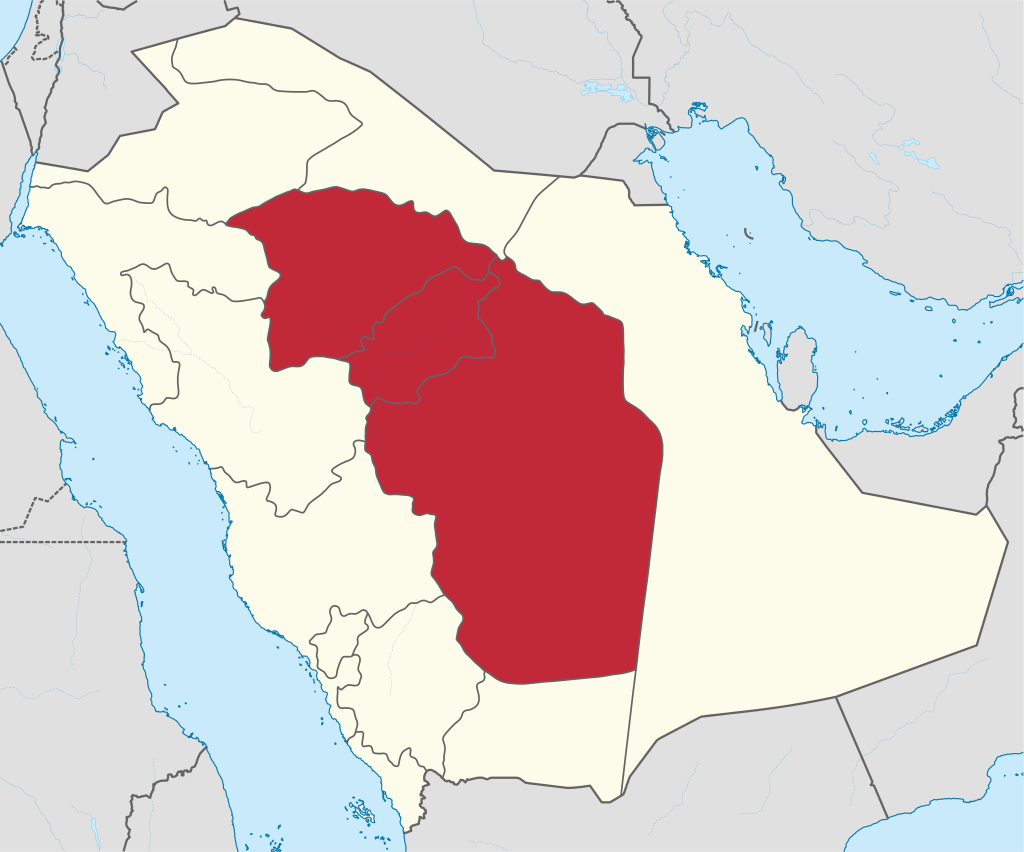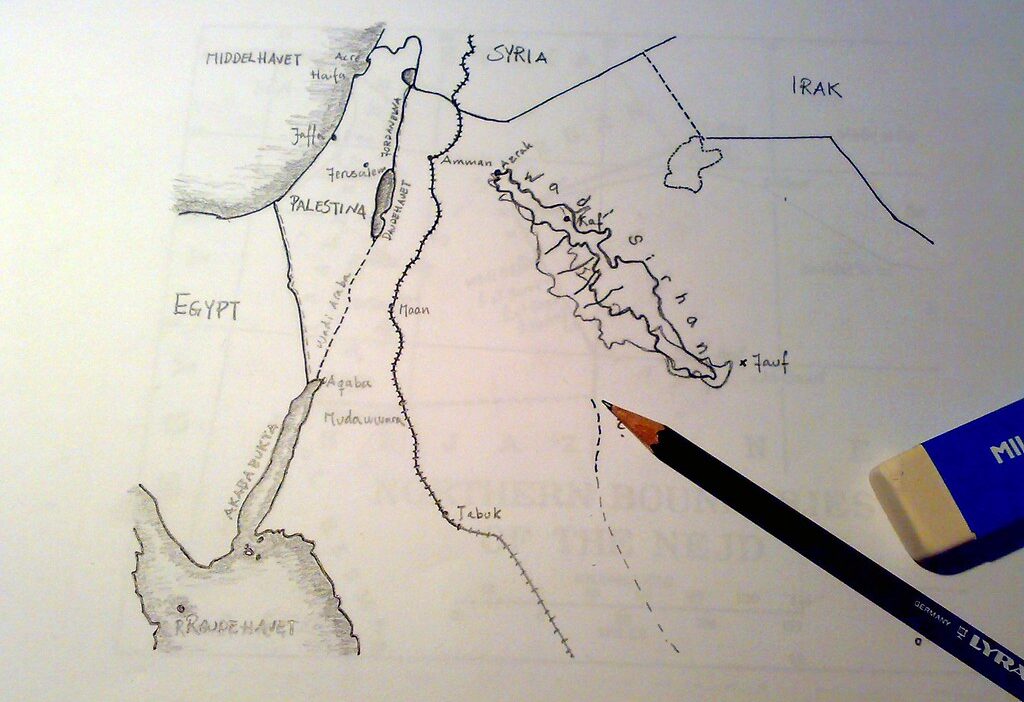Ever since Shaikh Muhammad Abdul Wahab eradicated shirk from Arabia, the claim that the hadith of Najd refers to central Arabia has become widely accepted. The fact that the dawah of Shaikh Muhammad Abdul Wahab began in ‘Uyayna in the Najd region of central Arabia is not disputed. So was the Prophet (salalahu alaihi wa sallam) therefore warning against the Najdi ‘Wahaabis’? Let’s examine the evidence.
The map below shows the Najd region of Saudi Arabia.

https://commons.wikimedia.org/wiki/File:Najd_Region_in_Saudi_Arabia.svg. TUBS, CC BY-SA 3.0 https://creativecommons.org/licenses/by-sa/3.0, via Wikimedia Commons
Let’s start by defining the meaning of Najd according to the classical scholars. Once this is understood, we will examine four hadith relevant to the discussion.
The meaning of Najd
Najd linguistically means elevation and height. In other words, it is that part of the land that is elevated and raised.
Al-Hafiz Ibn Hajar said: “The scholars of hadith and the imams of language agreed that Najd is not the name of a specific country nor the name of a specific town, but rather it is said of every piece of land that is elevated from what is around it” (is called Najd).1
Ibn Hajar also quoted al-Khattabi as saying: “Najd is from the direction of the east, and whoever is in Medina, his Najd is the desert of Iraq and its regions, and it is the east of the people of Medina. The origin of (the word) Najd is what is elevated from the land, and it is the opposite of the Gawr, which is lower than it.2
The Arabs referred to lands that were elevated with respect to them as Najd. One of the most commonly referred to areas at that time as Najd was Iraq. However, amongst the Arabs, there were thirteen places known as Najd depending on one’s location.
Ibn al-Atheer said, “Whoever was in Medina, his Najd was the desert of Iraq.”
Al-Nihiyyah. https://tinyurl.com/2v27b8c4
In summary, Najd refers to an elevated area in the direction of the East. It does not refer to a specific territory. In light of this, let us examine four hadith related to this discussion.
Hadith one
The Prophet (ﷺ) said, “O Allah! Bestow Your blessings on our Sham! O Allah! Bestow Your blessings on our Yemen.” The People said, “And also on our Najd.” He said, “O Allah! Bestow Your blessings on our Sham! O Allah! Bestow Your blessings on our Yemen.” The people said, “O Messenger of Allah! And also on our Najd.” I think the third time the Prophet (ﷺ) said, “There (in Najd) is the place of earthquakes and fitan (turmoil), and from there comes out the side of the head of Satan.”3
In this hadith ‘Najd’ is described as:
- A place where earthquakes and fitan (turmoil) will occur
- The area where side of the head (horn) of Satan will appear
Hadith Two
The Prophet salalahu alaihi wa sallam said: “O Allah! Bless our Sham and our Yemen. A man from the people said, “O Messenger of Allah! And our ‘Iraq?” He said, “Indeed there is the horn of the Satan….”4
In this authentic hadith we learn that the horn of Satan will emerge from ‘Iraq. The previous hadith stated that the horn of Satan will emerge from Najd. This hadith clarifies that the ‘Najd’ referred to in hadith one is Iraq.
Hadith Three
Salim b. `Abdullah b. `Umar said: “O people of Iraq, how strange it is that you ask about the minor sins but commit major sins? I heard from my father `Abdullah b. `Umar, narrating that he heard Allah’s Messenger (ﷺ) as saying while pointing his hand towards the east: Verily, the fitnah (turmoil) would come from this side, from where appear the horns of Satan, and you would strike the necks of one another.”4
In this report, Abdullah Ibn ‘Umar addresses and admonishes the people of Iraq with a hadith that refers directly to them. Allah’s Messenger (salalahu alaihi wa sallam) pointed to the East (i.e., to Iraq) and mentioned that fitnah and the horns of Satan will emerge from Iraq. Again, this concurs with and clarifies hadith one, which states that fitnah and the horns of Satan will emerge from Najd.
Hadith Four
Ibn Umar said: I saw the Messenger of Allah (salalahu alaihi wa sallam) pointing with his hand towards Iraq, “The fitnah (trial) is here, the fitnah is here,” three times from where the horn of Satan rises.”5
In this report, the Prophet (salalahu alaihi wa sallam) points towards Iraq, describing it as a place of fitnah. This correlates with the previous three hadith, leaving no doubt that the ‘Najd’ mentioned in the first hadith refers to Iraq. It is known by the scholars of hadith that the Prophet (upon him be peace) would sometimes make the same point on various occasions using different words.
Shaykh al-Albaani said: The versions of the hadith all indicate that the direction to which the Prophet (salalahu alaihi wa sallam) pointed was the East, specifically Iraq, as I have seen in some reports that state that clearly. This hadith is one of the signs of his Prophethood (salalahu alaihi wa sallam), because the first turmoil came from the east, and that was the cause of division among the Muslims. Similarly, innovations started from the same direction, such as the innovations of the Shi‘ah, Khaarijis and others.
Table of the four hadith
To summarise the salient points from each hadith, I have tabulated them.
| Hadith No. | What will emerge | Where it will emerge from | |
| 1 | Fitan (plural of fitnah) | Horn of Shaytan | Najd |
| 2 | Horns of Shaytan | Iraq | |
| 3 | Fitnah | Horns of Shaytan | Iraq |
| 4 | Fitnah | Iraq | |
The fitnah came from Iraq.
Many tribulations occurred in or from the people of Iraq, including:
- the martyrdom of Uthman, may Allah be pleased with him.
- the Battle of the Camel and Siffin
- the emergence of the Khawarij
- the martyrdom of Ali, may Allah be pleased with him
- the martyrdom of the Prophet’s blessed grandson, al-Husayn, may Allah be pleased with him
- the martyrdom of Zayd bin Ali bin Al-Husayn, may Allah have mercy upon him
- the emergence of the Mu’tazila and the Qadariyya
- the fitnah of denying that the Quran was the uncreated speech of Allah
- The Ash’arite school’s political consolidation
- the conspiracy of the Rafidah with the Tatars to overthrow of the Abbasid Caliphate in Baghdad which resulted in the massacre of hundreds of thousands of Muslims.
In addition, future tribulations will also come from Iraq, as foretold by the Prophet (salalahu alaihi wa sallam). These include the massacres that will occur when the river Euphrates uncovers a mountain of gold 6and the emergence of the Dajjal between Syria and Iraq.7
Now compare this to the tribulations that arose from the region called Najd in Saudi Arabia. Other than the emergence of Musaylimah the Liar8 from this region (in Yamamah), there is very little else.
Summary
Any objective study of the hadiths in question will lead to the conclusion that the Najd that the Prophet (salalahu alaihi wa sallam) referred to is Iraq. Any other interpretation can only be based upon misinterpreting the hadith to suit a sectarian agenda.
Further reading
https://forum.salafiri.com/viewtopic.php?t=133
- كتاب الشيخ محمد بن عبد الوهاب المجدد المفترى عليه
[أحمد بن حجر آل بوطامي] p112 ↩︎ - 13/51 فتح الباري ↩︎
- Sahih al-Bukhari 7094 ↩︎
- At-Tabarani 1204 ↩︎
- Sahih Muslim 2905f ↩︎
- (Musnad of Imam Ahmad: 143/2, and its chain of transmission is authentic). ↩︎
- Abu Hurayrah (may Allah be pleased with him) reported: The Messenger of Allah (may Allah’s peace and blessings be upon him) said: “The Hour will not occur until the Euphrates recedes, uncovering a mountain of gold over which people will fight. Ninety-nine out of every hundred will be killed. Every man among them will say: ‘I might be the one who survives.'” Another narration states: “Soon the Euphrates will recede uncovering a treasure of gold. Whoever is present at this event should not take anything from it.” Narrated by Bukhari & Muslim ↩︎
- Sahih Muslim 2936 ↩︎
- He claimed to be a Prophet during the lifetime of the Prophet Muhmmad salalahu alaihi wa sallam. He was killed in the battle of Yamamah during the caliphate of Abu Bakr as-Siddiqqe. ↩︎




